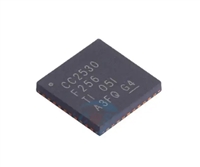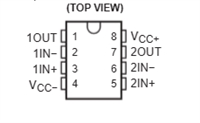| 是否无铅: | 不含铅 | 是否Rohs认证: | 符合 |
| 生命周期: | Active | 零件包装代码: | QFN |
| 包装说明: | HVQCCN, LCC28,.2SQ,20 | 针数: | 28 |
| Reach Compliance Code: | compliant | ECCN代码: | EAR99 |
| HTS代码: | 8542.39.00.01 | 风险等级: | 1.63 |
| Samacsys Confidence: | 3 | Samacsys Status: | Released |
| 2D Presentation: | https://componentsearchengine.com/2D/0T/357268.3.1.png | Schematic Symbol: | https://componentsearchengine.com/symbol.php?partID=357268 |
| PCB Footprint: | https://componentsearchengine.com/footprint.php?partID=357268 | 3D View: | https://componentsearchengine.com/viewer/3D.php?partID=357268 |
| Samacsys PartID: | 357268 | Samacsys Image: | https://componentsearchengine.com/Images/9/A4988SETTR-T.jpg |
| Samacsys Thumbnail Image: | https://componentsearchengine.com/Thumbnails/3/A4988SETTR-T.jpg | Samacsys Pin Count: | 29 |
| Samacsys Part Category: | Integrated Circuit | Samacsys Package Category: | Quad Flat No-Lead |
| Samacsys Footprint Name: | ET Package, 28-Pin QFN with Exposed Thermal Pad | Samacsys Released Date: | 2017-01-10 14:38:01 |
| Is Samacsys: | N | 模拟集成电路 - 其他类型: | STEPPER MOTOR CONTROLLER |
| JESD-30 代码: | S-XQCC-N28 | JESD-609代码: | e3 |
| 长度: | 5 mm | 湿度敏感等级: | 2 |
| 功能数量: | 1 | 端子数量: | 28 |
| 最高工作温度: | 85 °C | 最低工作温度: | -20 °C |
| 最大输出电流: | 2 A | 封装主体材料: | UNSPECIFIED |
| 封装代码: | HVQCCN | 封装等效代码: | LCC28,.2SQ,20 |
| 封装形状: | SQUARE | 封装形式: | CHIP CARRIER, HEAT SINK/SLUG, VERY THIN PROFILE |
| 峰值回流温度(摄氏度): | 260 | 电源: | 35 V |
| 认证状态: | Not Qualified | 座面最大高度: | 1 mm |
| 子类别: | Motion Control Electronics | 最大供电电流 (Isup): | 8 mA |
| 最大供电电压 (Vsup): | 5.5 V | 最小供电电压 (Vsup): | 3 V |
| 标称供电电压 (Vsup): | 3.3 V | 表面贴装: | YES |
| 技术: | DMOS | 温度等级: | OTHER |
| 端子面层: | Matte Tin (Sn) | 端子形式: | NO LEAD |
| 端子节距: | 0.5 mm | 端子位置: | QUAD |
| 处于峰值回流温度下的最长时间: | 40 | 宽度: | 5 mm |
| Base Number Matches: | 1 |
| 型号 | 品牌 | 描述 | 获取价格 | 数据表 |
| A4989 | ALLEGRO | The A4989 is a dual full-bridge gate driver with integrated microstepping translator suita |
获取价格 |

|
| A4989SLDTR-T | ALLEGRO | The A4989 is a dual full-bridge gate driver with integrated microstepping translator suita |
获取价格 |

|
| A4990KLPTR-T | ALLEGRO | Stepper Motor Controller, PDSO20, 4.40 X 6.50 MM, 1.20 MM HEIGHT, LEAD FREE, MO-153ACT, TS |
获取价格 |

|
| A4992 | ALLEGRO | Automotive Stepper Driver |
获取价格 |

|
| A4992KLPTR-T | ALLEGRO | Automotive Stepper Driver |
获取价格 |

|
| A49FL004 | AMICC | 4 Mbit CMOS 3.3Volt-only Firmware Hub/LPC Flash Memory |
获取价格 |

|

 MC34063开关稳压器:全面参数解析与设计指南
MC34063开关稳压器:全面参数解析与设计指南

 CC2530无线微控制器:资料手册参数分析
CC2530无线微控制器:资料手册参数分析

 NE5532双低噪声运算放大器:资料手册参数分析
NE5532双低噪声运算放大器:资料手册参数分析
